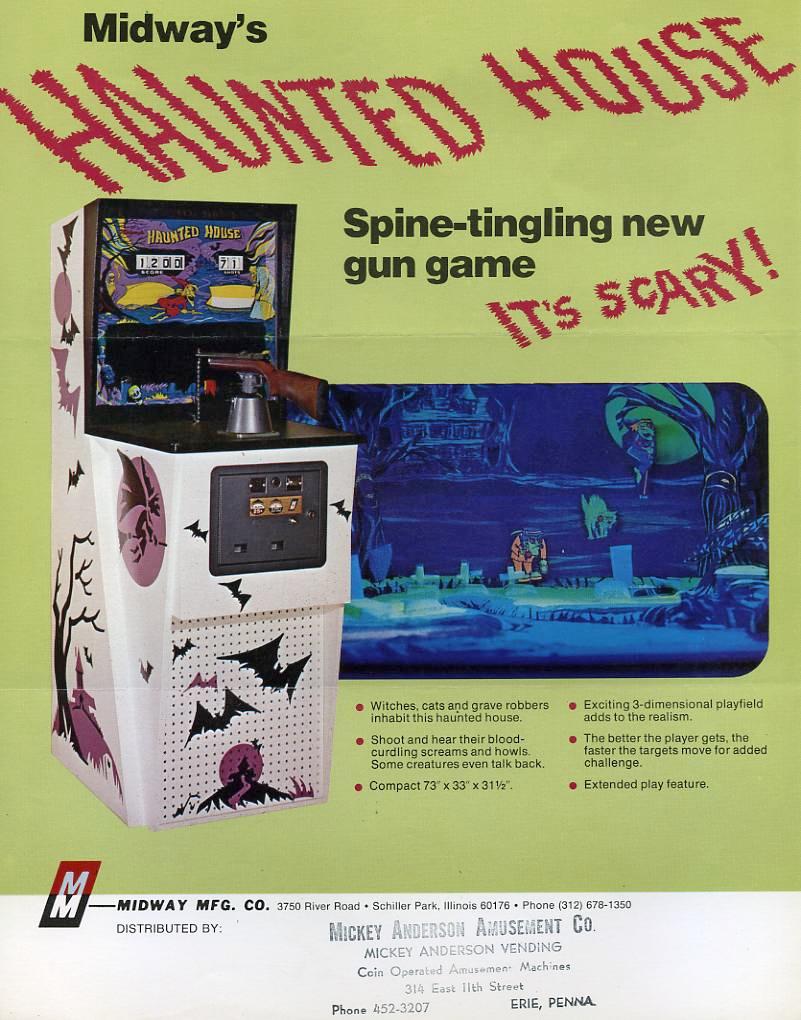
|
Description: Haunted House, Midway #553, 1/72, gun game with two cats, a witch, and a grave robbing monster. Blacklight lighting, 8-track player sound loop 2 minutes 42 seconds long, uses a special 4-channel 8-track player (one track is used for background "spooky" sounds, and three other tracks have sound effects for specific targets: monster, cat, witch). Gun has recoil and there are two circuit boards in the back of the game for amplification and motor speed control. The target motor speed increases at 1000, 2000 and 3000 point levels making them harder to hit. Game gives 20 shots with unlimited time. If a certain score is reached, 10 more shots are awarded. Midway Haunted House's theme is a good one, and the sound affects are very good, but it's not that great of a target shooting game. The biggest selling point of the game is the theme and the sounds. Note sales flyer game size specifications are wrong (26" wide 35" deep is correct). The background 8-track sound plays continually, but the tape skips to the needed track as game play advances. Background sound is the main track, and is by default playing at game start. When the player hits one of the targets (ghose, cat, witch), the 8track jumps to one of the other four tracks for a set time (about 3 seconds.) This momentarily halts the background sound, as the target sound is played. Since the 8track tape is constantly moving, the target sounds often play the end half of one 3 second burlb, and the start of another 3 second burlb. It sounds weird, depending on the timing of the hit. But this was the most advance sound ever done in an arcade game to this point (1972.) Personally I find the track jumping to be a bit clunky. The sound effects in 1971 Midway Wild Kingdom are less clunky, but not nearly as "cool" as Haunted house. Note the 8track player determines the sound hit time for the cat/monster/witch, not the game. Which of course implies the 8track player is custom to this game. The other sound the game makes is the gun shot sound. This is done on the amplifier board in the top back of the game. So if you are missing the 8track, you should still get a gun shot sound, assuming your amplifier board is working. If you have a Midway Haunted House gun game for sale please contact me at cfh@provide.net
Midway Haunted House Sound Tracks.
8-Track Tape Player Description. The pinout for the 9-pin connector on the 8track player is as follows:
8-Track Tape Replacement. A different approach could be taken where the cat/witch/monster sound track is broken into individual sounds, and those randomly played by the MP3 players when needed. But that is significantly more complicated. and would involve a more advanced MP3 player(s) that has a random shuffle feature. And maybe some programming to make it work. Of course you'll have to edit the three cat/witch/monster sound tracks into separate sounds too, which will take some time.
Implementing an MP3 Replacement System.
The relay boards keep their particular Mp3 player's speaker connection (cat/witch/monster) open until triggered. Then the relay board closes its relay for about 3 seconds (and the green LED on the relay board goes ON, which is a nice visual for diagnostics), allowing the speaker to play that sound (cat/witch/monster). This mimics the 8track system. The down side is you will need to run a single wire from the 30 degree relay on the back door to the power supply. The yellow/green wire on the 30 degree relay carries 16vdc volts, and that will need to be disconnected, and a new ground wire (going to the ground on the 5v/12v power supply) connected to the relay in its place. The original 8track player's nine pin connector (part of the game's wiring harness) will need three lines, which connect to the Mp3 player. Pin1 (cat), Pin2 (witch) and Pin9 (monster) will need to be tapped and go to the respective relay boards. That way when one of these targets is hit during game play, the game's logic will trigger the relay board (through that new ground wire), and close the appropriate relay board for the needed 3 second play time. Because we only need three lines from the 8track player wiring harness, I recommend using a .062" Molex connector. You could make a male printed circuit board to mate to the original 8track connector, but that seems like a lot more work, and a less reliable connection. On the relay board, I used the board linked above. It has two pots, but with the board set to "T" time or T/10 time, it was tricky to get the timing set to exactly 3 seconds. There are two movable feature adjustments on this board. I ended up setting the timing to "T" and "Mono" (single relay closure). With this configuration the second pot is not used. Since the pot was so hard to get set, I replaced the 500k timing pot with two resistors: 450k and 3k. This simulates the pot and gives a nice 3 second relay closure (you can micro manage the smaller resistor from 2.7k to 3.2k to slightly change the timing interval.) With hard resistors there's no pot to ever move or change the timing adjustment. I also added a micro switch on each relay board as a test switch. Hold the switch closed, and you'll simulate the relay board function. Optional but a nice feature, especially when adjusting volume to balance the multiple Mp3 players' volume. One more point on the relay board linked above... the Trigger line is actually two wires, but you only want to use *one* of the two lines. That would be the line labeled "key". This line gets shorted to ground, and it activates the relay board, and turns on the appropriate sound (cat/witch/monster) for 3 seconds. The second trigger wire should *not* be used, just cut that wire and ignore it. Again just the one trigger wire is used, the one labeled "key." The background sound Mp3 player is the easiest to implement. It needs no input, it just starts running the background sound as soon as a game is started. So no relay board is needed for the background sound track. Unlike the 8track where it needed to move the tape head to and from the background sound track, this is not required for the Mp3 player system. It also means there's no required trigger from the 8track player's connector needed. The 5v switching power supply on some of these "DF" style Mp3 boards should have it's 5v turned down to about 4.5 volts. On the Mp3 player I'm using in this example, 5 volts can be 5 volts. But other DF style Mp3 boards can run better at a lower voltage, with less heat and less audio artifacts. Of check check voltage with all the Mp3 running. The power supply should have a 5v adjustment pot. Remember these inexpensive Mp3 players are really a 3.3v device. If you run 5v at say 5 volts, the player can have issues and fail. Probably not a huge deal here as the player is only powered for the length of a game (less than 2 minutes at a time.) But this is worth mentioning. Many (not all) of the cheap "DF" Mp3 players are like this. Just keep this in mind. An easy way to tell is if your Mp3 player has 5watt output, then 5v is 5v. If you are using a 3watt Mp3 player, then the 5v needs to be more like 4.5v. Below at the end of this page are pictures and a schematic of the 8-track tape replacement system.
|

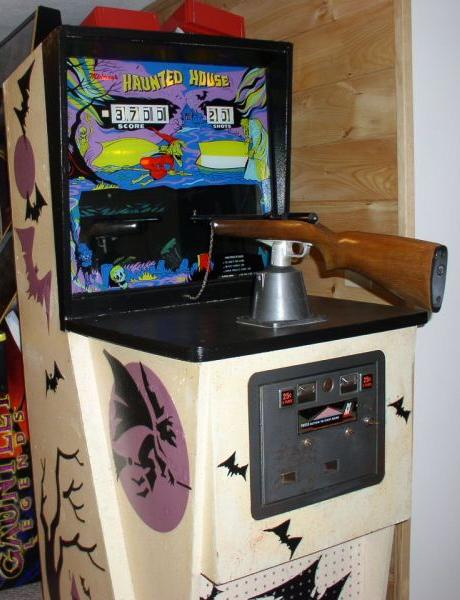
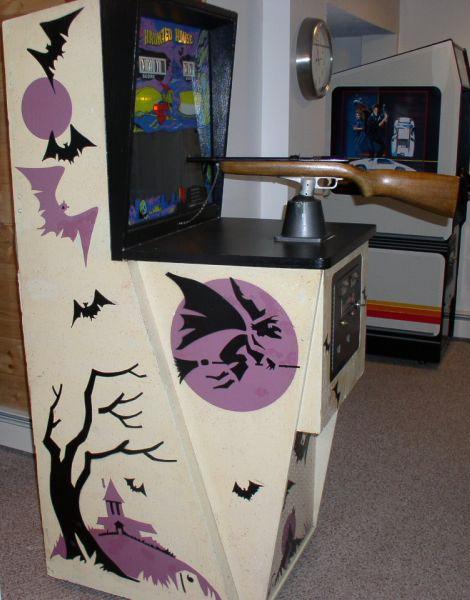
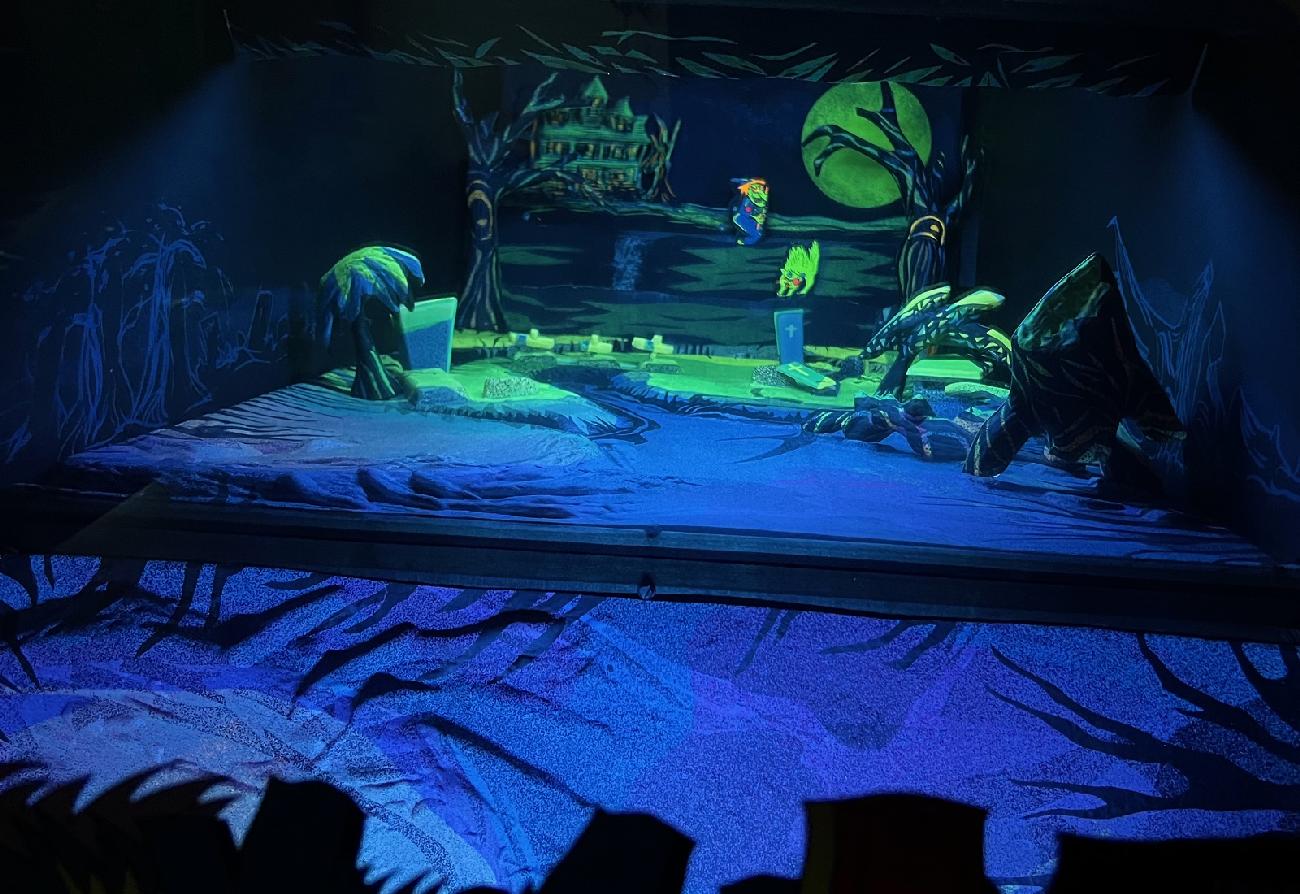
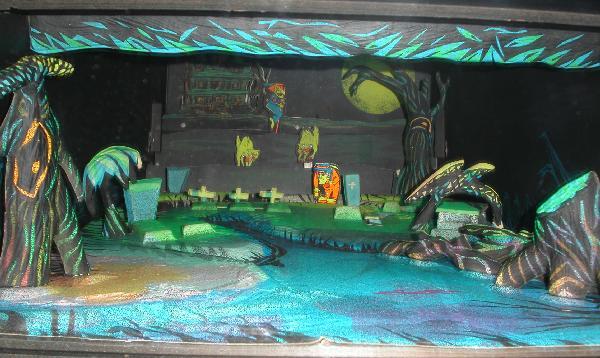
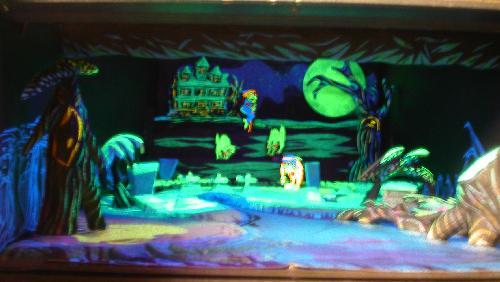
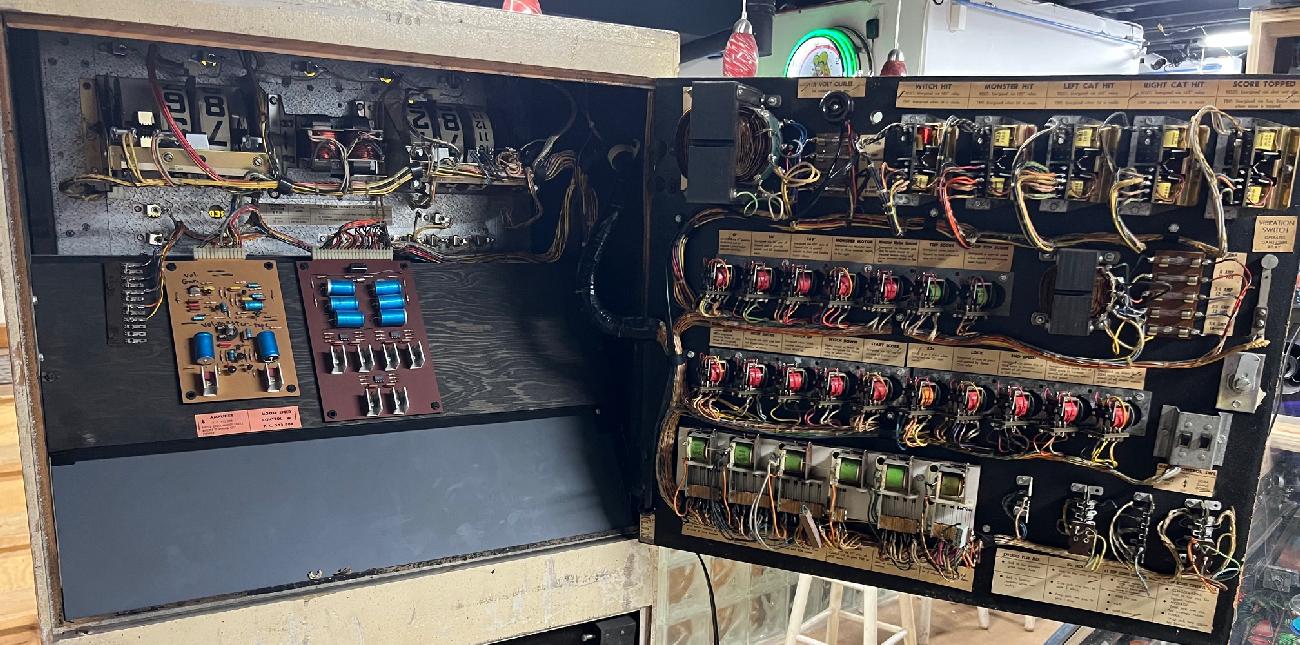
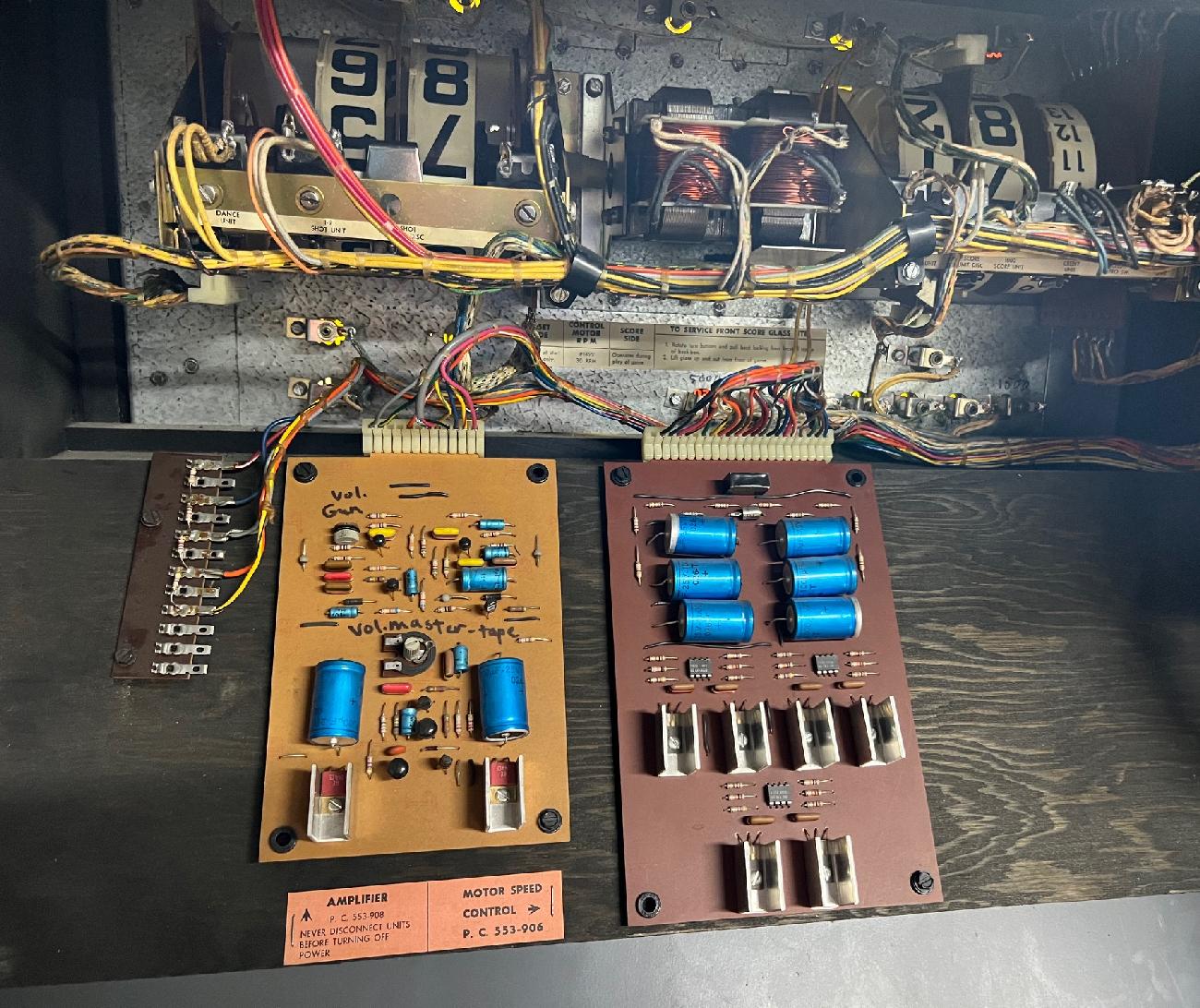
Custom Midway Haunted House 8-track tape player.
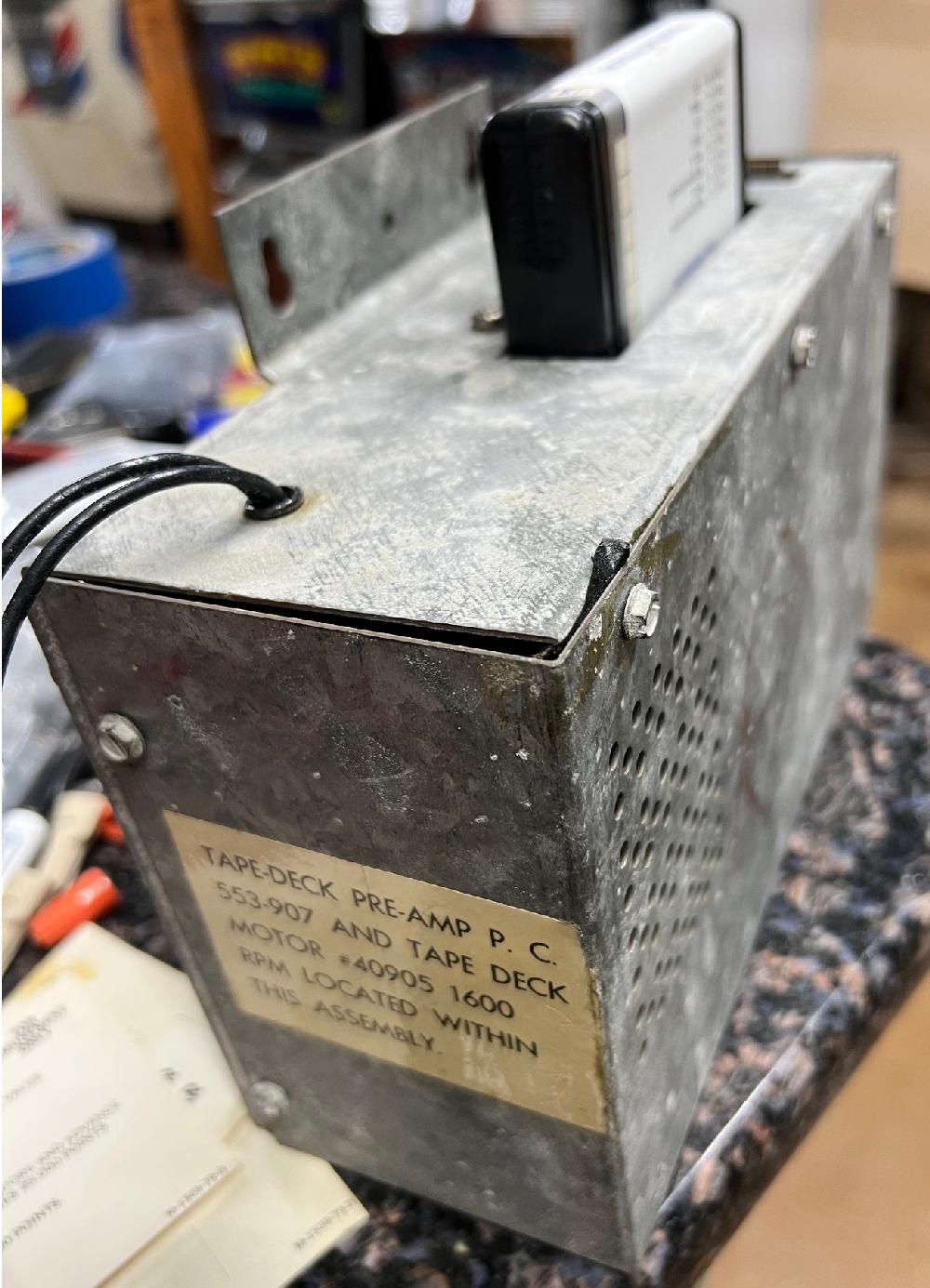
Custom Mp3 player unit to replace the 8-track system:
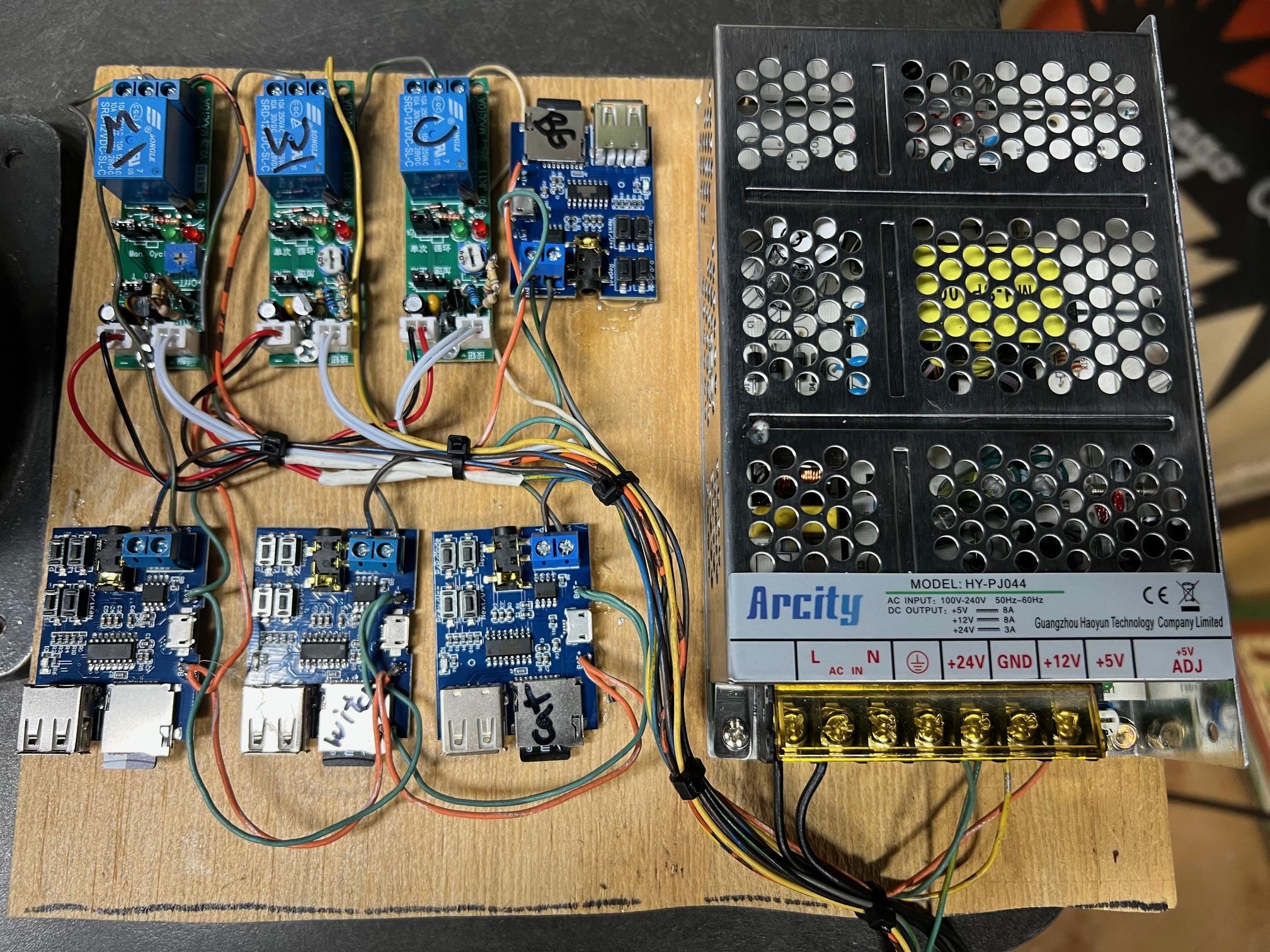
Relay board showing the trigger line "key" and the Mono option selected.
Also the time trim pot was replaced with a 3k and 450k resistors.
And lastly, a small micro switch is added to the relay terminals, which is used as a Test switch for that sound.
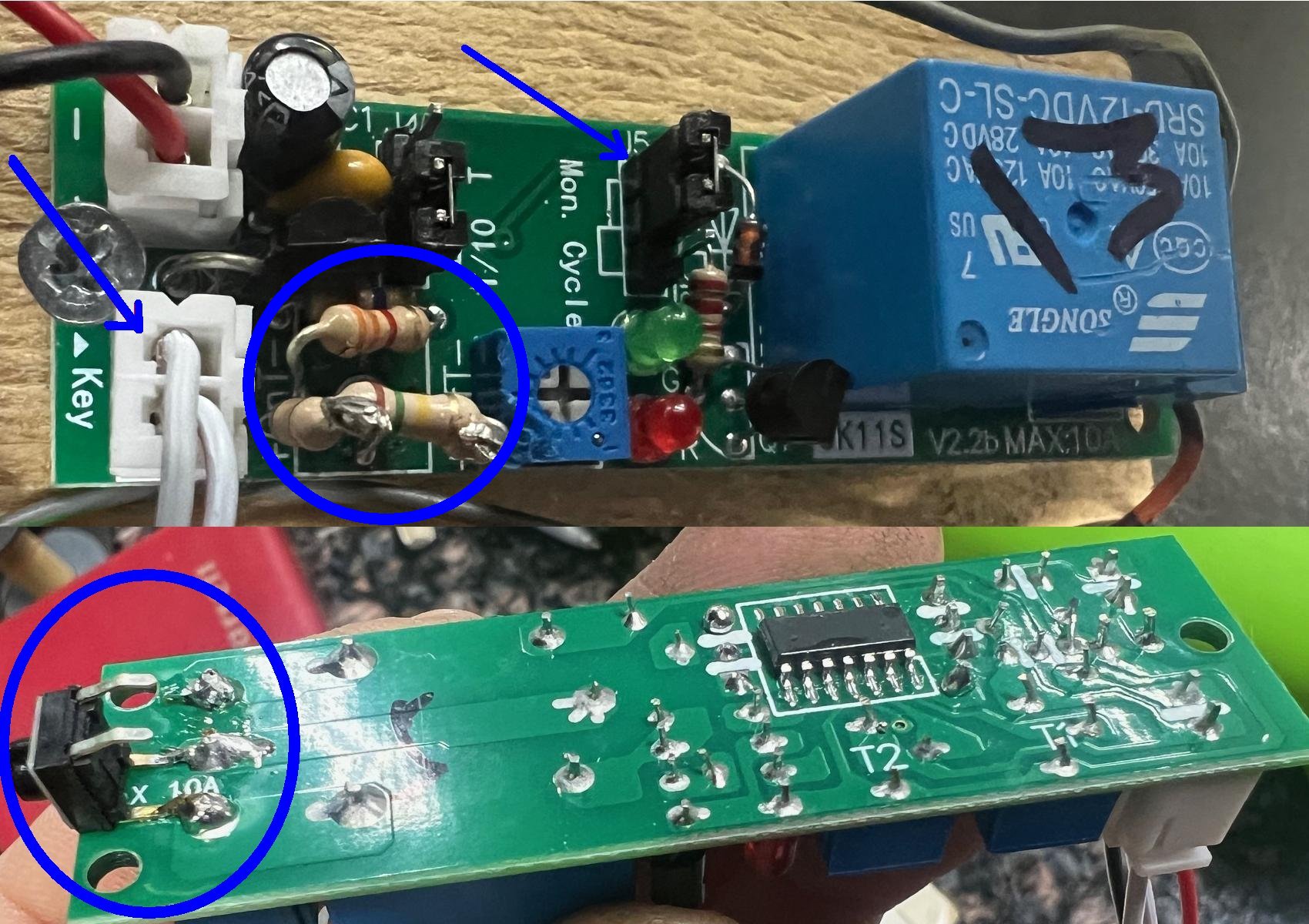
The green ground wire added from the new Mp3 power supply to the 30 degree relay.
On this game, I wanted to be able to switch back and forth between the 8-track and the Mp3 player.
Hence the switch. But if the Mp3 was a permanent addition, the added green ground wire would replace
the yellow/green wire that solders to the bottom right lug of the 30 degree relay.
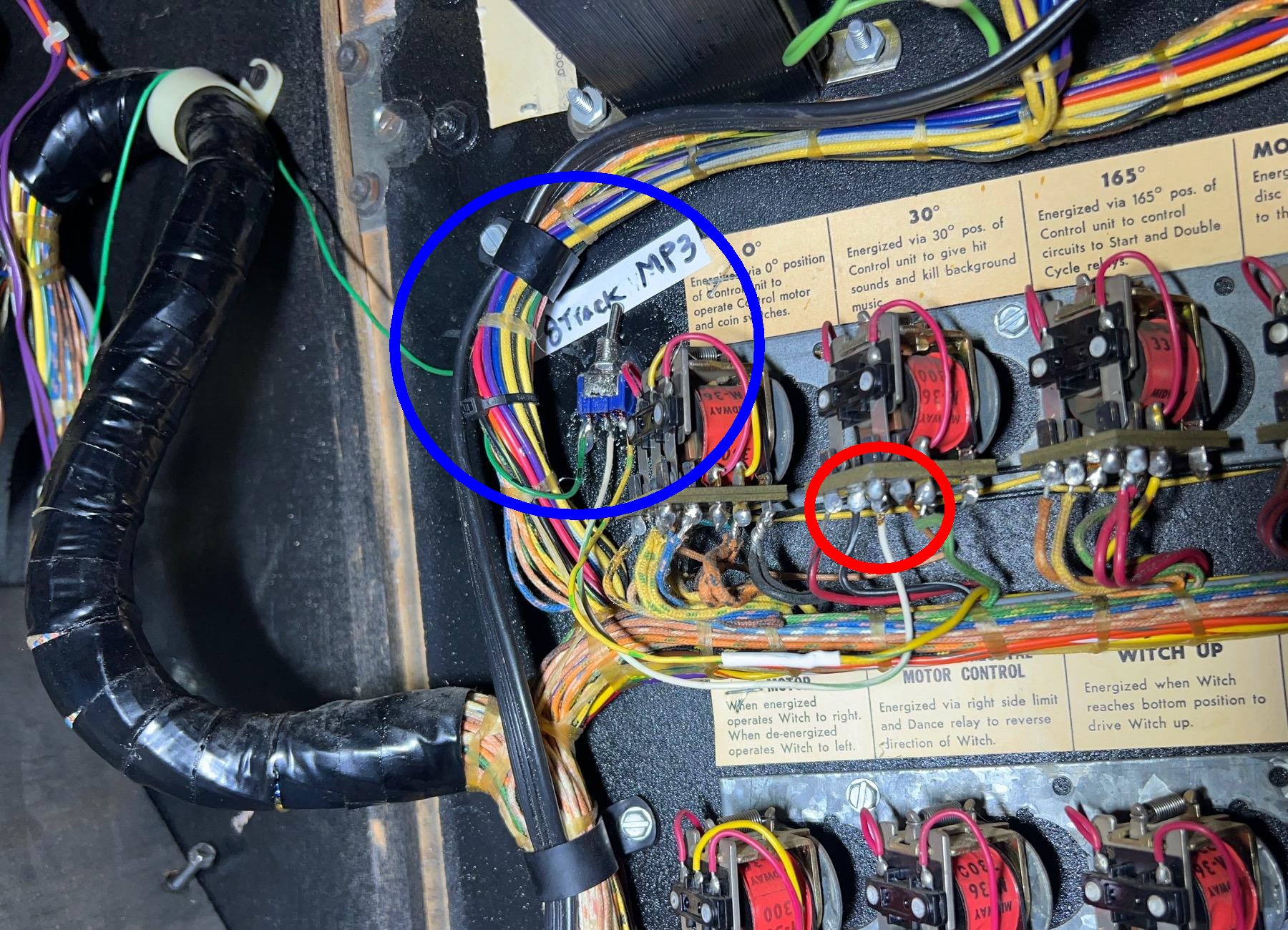
Four speakers installed for the four Mp3 players. Mounted using "GOOP".
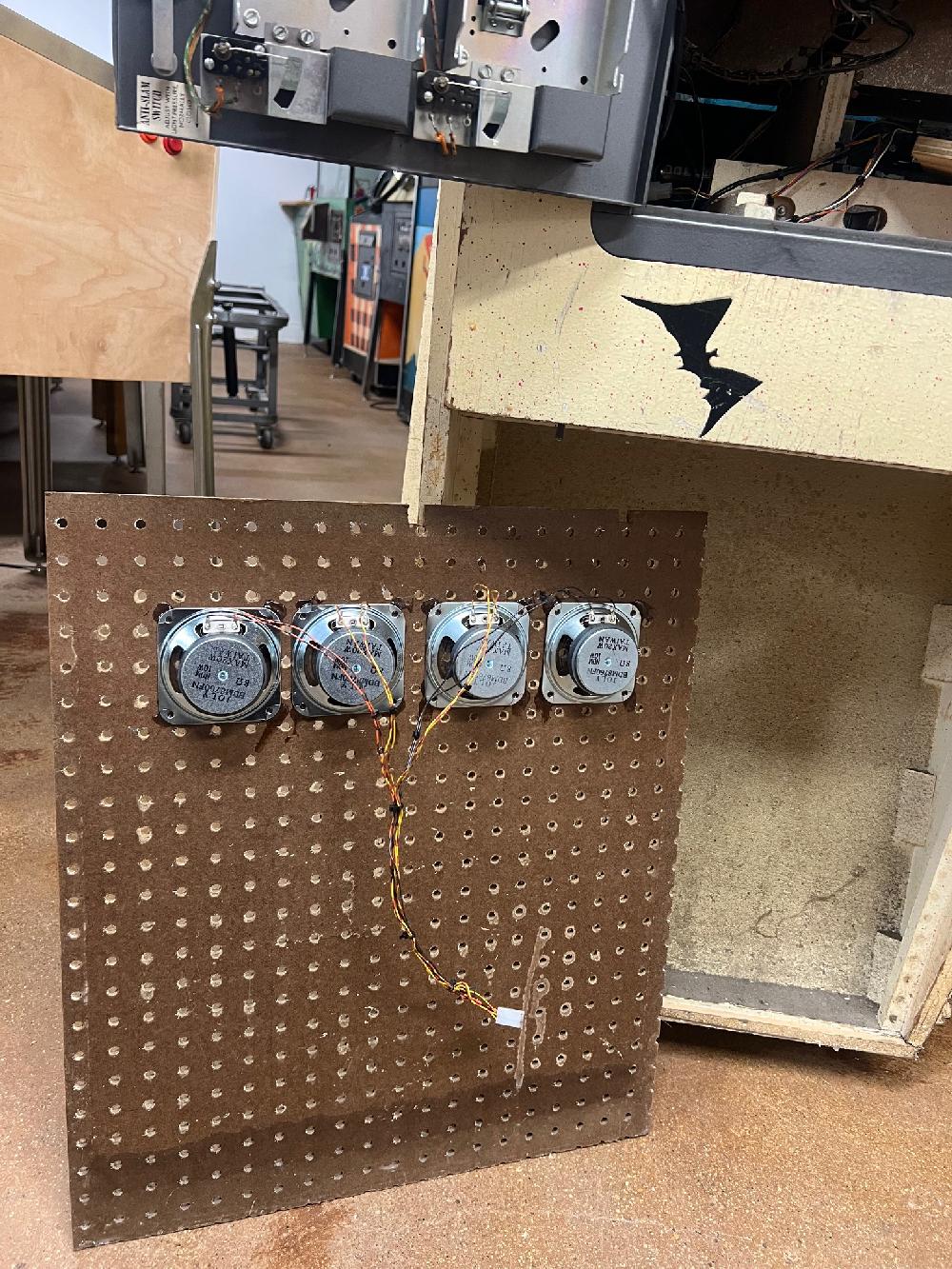
Schematic for the Midway Haunted House Mp3 replacement system:
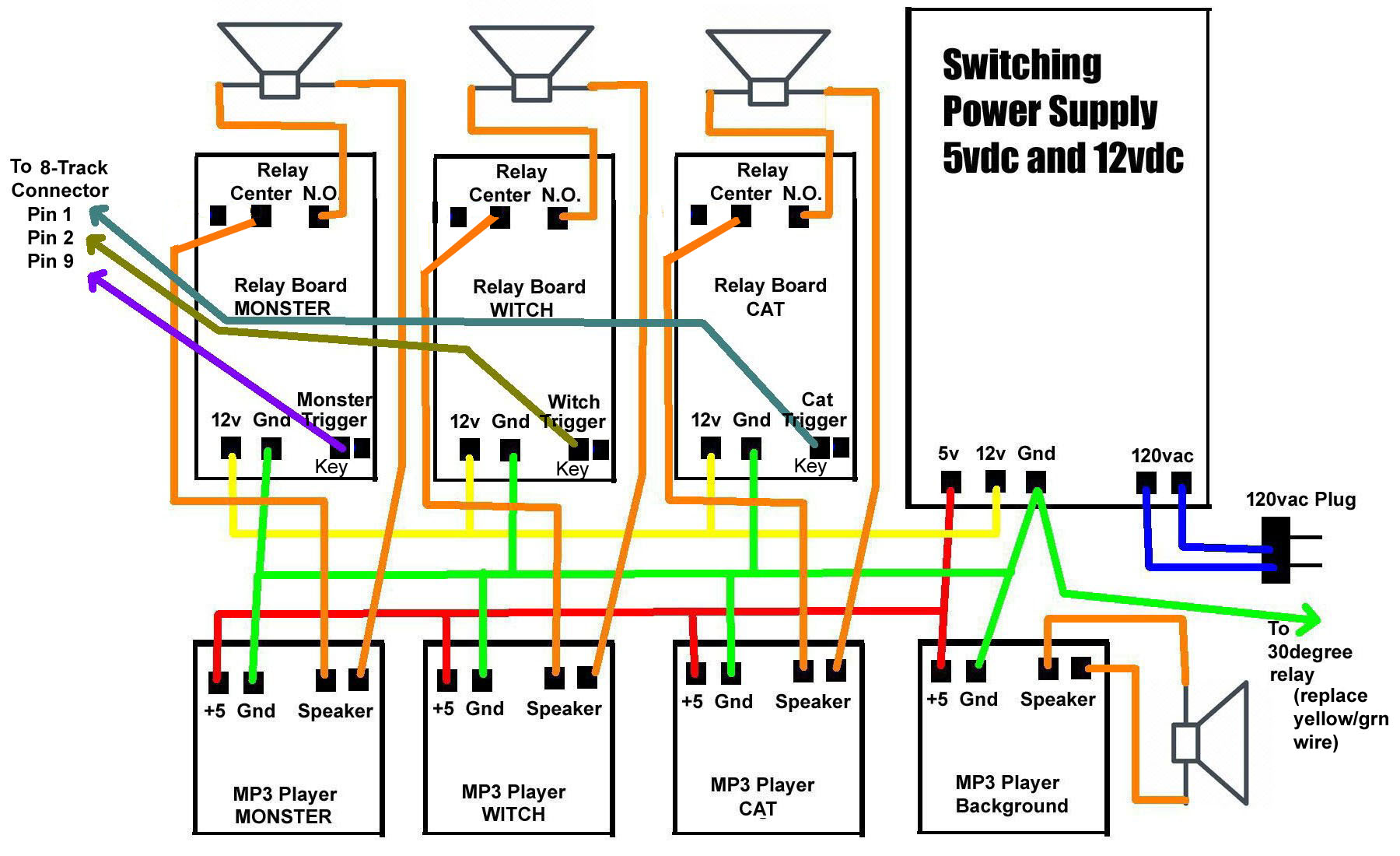
|
* Email the collector cfh@provide.net * Go to the EM Arcade History index * Go to the Pinball Repair/History index |